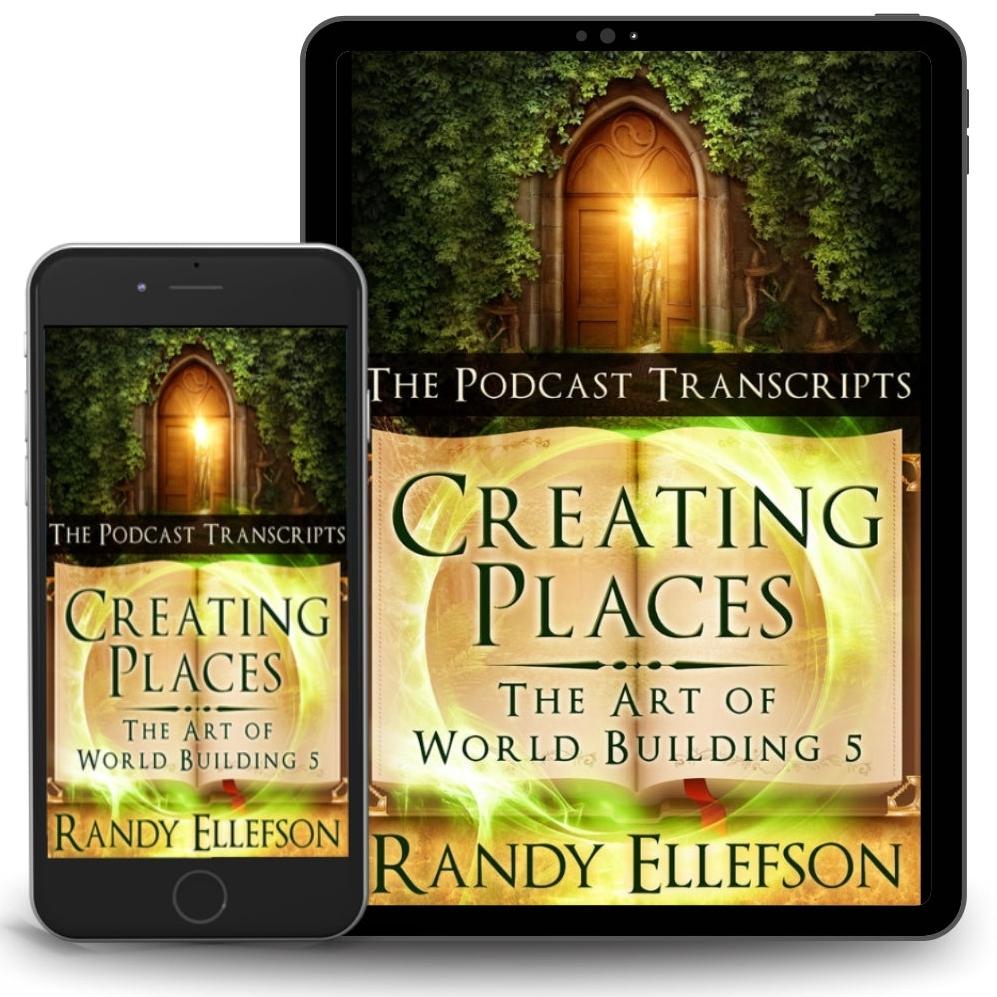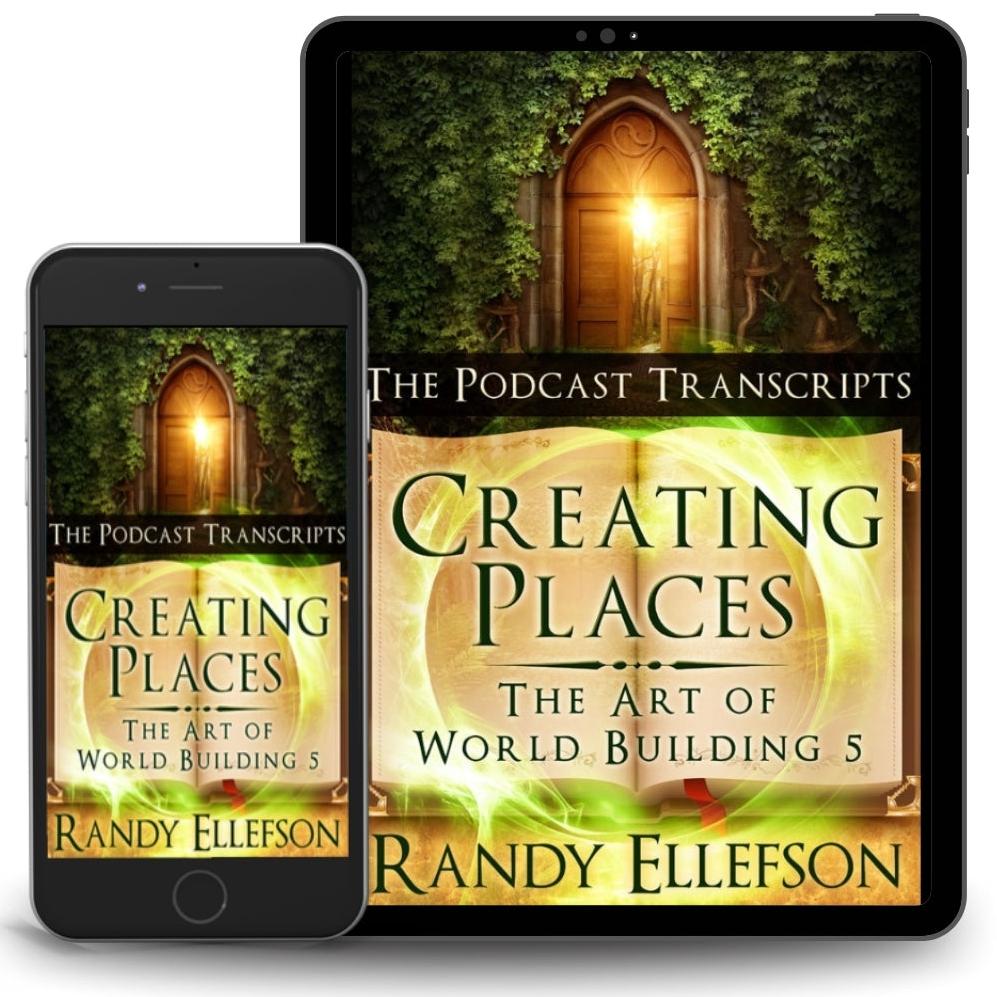Creating Places - The Podcast Transcripts (The Art of World Building, #5) (eBook)
Creating Places - The Podcast Transcripts (The Art of World Building, #5) (eBook)
4.4 Stars, 11 Amazon Ratings (as of 1/2024)
Learning to create a unique, immersive place one podcast episode at a time.
World building strategist Randy Ellefson turned his successful book series, THE ART OF WORLD BUILDING, into a popular podcast of the same name, with episodes loosely drawn from each book in the series. Listeners who want a written copy, or those who want more details than what’s in volume two, can now benefit from these transcriptions. CREATING PLACES – The PODCAST TRANSCRIPTS (THE ART OF WORLD BUILDING, #5) includes 16 episodes that interweave content from across the series.
While covering much of the same material as volume two, Ellefson breaks out in new directions while expanding on how to invent planets, continents, sovereign powers, settlements, history, maps, and more. He also teaches experts and beginners alike how latitude, prevailing winds, and mountains affect climate and where vegetation grows. Learn how long it takes to travel over different terrain types and conditions by horse, wagon, sailing vessels, or even dragons.
Build better, faster.
Couldn't load pickup availability
Share

Product Details
FAQs: How Will I Get My eBook?
eBooks are delivered instantly by link in your confirmation email (and as a backup, also by email from our delivery partner, BookFunnel).
FAQs: How Do I Read My eBook?
You can read the eBooks on any e-reader (amazon, Kobo, Nook), your tablet, phone, computer, and/or in the free BookFunnel app.
Read a Sample
Episode 11 Part 2 - Creating a Planet
Basics on Climate
When it comes to climate, there are things that affect the entire planet’s climate, and then there are things that are happening on a more regional level. So, first, we’re going to talk about that bigger picture, and the two primary things we want to focus on are the equator’s role and then the role of the ocean.
The Equator
Let’s first talk about the equator. We all know what one is, but it’s basically an imaginary line. You know, it doesn’t actually exist. It’s just a line that’s equally distant between the north pole and the south pole. One of the things about the equator is that days and nights are exactly at the same length there year round. This changes the farther north or south you go, to the point where it can be night for six months and then day for six months at one of the poles.
It’s also perpetually hot there, except in higher altitudes where it’s a little bit cooler. As a general rule, things tend to remain the same at the equator, and the equator is some-times the exception to some of the other climate things that we’re going to talk about today. Since things stay the same, one of the things we don’t really have at the equator is the normal four seasons that most of us experience.
They just don’t exist. Well, technically, they do exist, but they’re so subtle that they may as well not. If you are building a fantasy world where the characters in that region never leave that area, then they may not even understand the idea of the seasons, the same way that they would have never seen snow.
Now, they do have something instead of the four pronounced seasons, and that is basically a wet season and a dry season. Some places are actually wet all year, but many of them are just wet for something like 200 days a year on Earth. Of course, this means that they are predominantly wet. If you don’t like rain, you probably don’t want to live near the equator.
And, now, if you’re building a world where there are inhabitants who never leave the equator, then they are probably very used to the rain. They probably take it for granted and their culture as likely to have something to do with this abundant rainfall. Life in this area is often based upon the rain. If you are setting a story at the equator, you should take into account that it’s probably going to be raining on the characters most of the time. If this is something you don’t want in your story, then you might want to move it further from the equator.
For those of us who write science fiction, you may have wondered why space craft on Earth are usually launched from Florida, and the reason is that this is closest to the equator in the United States. The reason this matters is that the escape velocity needed to escape our atmosphere is less at the equator because the planet is spinning faster there.
So, if we’re building a science fiction planet, we might want to consider this. We may have decided that the propulsion systems on that planet are so powerful that they don’t need to worry about this anymore, but it could be more realistic to decide that they do still need to worry about this, and plan our strategy and our books more with that in mind.
One thing you can do is have a kingdom that is near the equator and, therefore, it is in control of the territory on that continent. And there’s another kingdom further north, for example, and that kingdom, the northern one, wants to send spaceships into space, but it has a harder time doing so because it’s farther from the equator. And this might cause it to try engaging in a war to gain territory that is closer to the equator. So, this is one way in which our re-search into world building and how the planet works, and just physics, can help us think of a story scenario.
In the previous episode, we talked about the Earth spinning counter-clockwise, which is why the sun is rising in the east and setting in the west. This is important to re-member as we continue through this episode, because some of the other issues I’m going to talk about have some-thing to do with which direction the winds are going and that is based on the direction that the planet is spinning, in part. But the reason I mention it right now is that in order for spacecraft to take advantage of this, they have to launch in an easterly direction. So, you could, again, have another scenario where two kingdoms do have territory near the equator, but one of them must launch its space-craft over the other one to get into space and, as a result, it’s very likely to be shot down. Of course, this is assuming that they are enemies.
Personally, I find this kind of detail more interesting, and this is part of what I alluded to at the beginning, where understanding climate and other things about our planet can make the subject of climate more interesting. And, in this case, it can also impact our story and add a nice bit of realism to what we are doing.
Another issue we should talk about when it comes to the equator is that when we are inventing a continent for our world, we should always make an early decision how far from the equator this continent is. This may not seem like it matters at first, but the distance from the equator is going to determine the direction of the prevailing winds, and those are what carry moisture from one place to an-other, and that moisture can be blocked by mountains. And that is going to cause something that we’re going to talk about in a few minutes called “rain shadows.” This also causes the location of deserts and forests, so all of this is related to how far from the equator is this landmass.
If you’re not sure why any of that matters, by the time we conclude this podcast episode, you will.
Table of Contents
Episodes Included
11.1 and 11.2: How to Create Planets
12: How to Create a Continent
13.1 and 13.2: How to Create Land Features
14.1, 14.2, and 14.3: How to Create Sovereign Powers
15.1 and 15.2: How to Create Settlements
16: Travel Over Land
17: Travel Over Water
18: Travel In Space
19: Create Time & History
20: Create Places of Interest
21: How To Create Maps
Availability at Retailers
It’s financially beneficial to any artist to buy directly from them, but this product may be available at these retailers.

